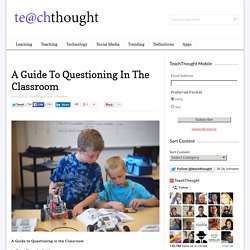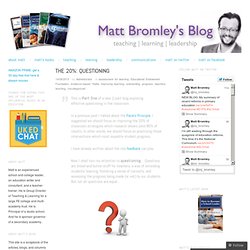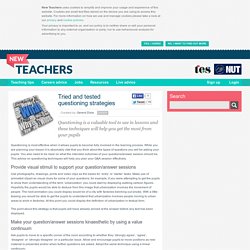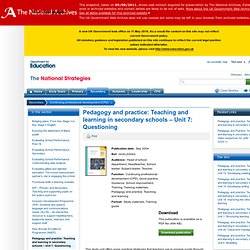

A Quick Guide To Questioning In The Classroom. A Guide to Questioning in the Classroom by TeachThought Staff This post was promoted by Noet Scholarly Tools who are offering TeachThought readers 20% off their entire order at Noet.com with coupon code TEACHTHOUGHT (enter the coupon code after you’ve signed in)!

Get started with their Harvard Fiction Classics or introductory packages on Greek and Latin classics. Noet asked us to write about inquiry because they believe it’s important, and relates to their free research app for the classics. This is part 1 of a 2-part series on questioning in the classroom. Something we’ve become known for is our focus on thought, inquiry, and understanding, and questions are a big part of that. If the ultimate goal of education is for students to be able to effectively answer questions, then focusing on content and response strategies makes sense. Why Questions Are More Important Than Answers The ability to ask the right question at the right time is a powerful indicator of authentic understanding.
Www.rtuni.org/uploads/docs/Questions worth asking.pdf. What students think of questioning, feedback, independence and challenge. The 20%: Questioning. This is Part One of a new 2-part blog exploring effective questioning in the classroom.In a previous post I talked about the Pareto Principle.

I suggested we should focus on improving the 20% of classroom strategies which research shows yield 80% of results. In other words, we should focus on practising those interventions which most expedite student progress.I have already written about the role feedback can play.Now I shall turn my attention to questioning… Questions are bread-and-butter stuff for teachers, a way of extending students’ learning, fostering a sense of curiosity, and assessing the progress being made (or not) by our students.
But not all questions are equal… In an article written as long ago as 1985 – in the days before the National Curriculum and Assessment for Learning, Jos Elstweet observed a lesson and made the following comments: I once witnessed a marvelous science lesson virtually go to ruins. Stick Pick for iPhone, iPad and iPod touch on the iTunes App Store. How to move your lessons from good to outstanding. Where would I be without Twitter?

I have decided to elaborate on this AfL strategy, following this tweet from my @TeacherToolkit account on #ukedchat 3.11.11. My tweet said "#ukedchat Missed out tonight, look forward to reading ideas. My favourite T&L strategy at the moment is "Pose, Pause...Pounce, Bounce" #AfL". Firstly, this concept is not mine. So it is at this point, where I will be honourable and credit a colleague who I think has a money-spinning idea here.
The fabulous Mrs Pam Fearnley delivered the session. What is it? It is a simple, yet sophisticated, AfL (Assessment for Learning) questioning technique to help teachers move from good-to-outstanding. Why is it useful? For many reasons. The strategy encouraged teachers to take risks and tease out the "learning" in class. How does it work? I have listed the four-part approach below with additional information that I hope explains the method. . • Give the context of your approach to the class. This is the hard part. Tried and tested questioning strategies. Questioning is most effective when it allows pupils to become fully involved in the learning process.

While you are planning your lesson it is absolutely vital that you think about the types of questions you will be asking your pupils. You also need to be clear on what the intended outcomes of your questions/answer session should be. This advice on questioning techniques will help you plan your Q&A session effectively. Provide visual stimuli to support your question/answer sessions Use photographs, drawings, prints and video clips as the bases for ‘entry’ or ‘starter’ tasks. The point about this strategy is that pupils will have already arrived at the answer before any text has been displayed. Make your question/answer sessions kinaesthetic by using a value continuum Ask pupils to move to a specific corner of the room according to whether they ‘strongly agree’, ‘agree’, ‘disagree’ or ‘strongly disagree’ on a particular issue. Use the ‘mirroring’ technique Use the ‘hot air balloon’ technique. Questioning - Top Ten Strategies.
“Learn from yesterday, live for today, hope for tomorrow.

The important thing is to not stop questioning.” – Albert Einstein Questioning is the very cornerstone of philosophy and education, ever since Socrates ( in our Western tradition) decided to annoy pretty much everyone by critiquing and harrying people with questions – it has been central to our development of thinking and our capacity to learn. Pedagogy and practice: Teaching and learning in secondary schools – Unit 7: Questioning. Publication date: Sep 2004 Ref: Audience: Head of school department, Headteacher, School leader, Subject leader, Teacher.

T&L Questioning. Questioning techniques. Teachers TV- Effective Questioning.